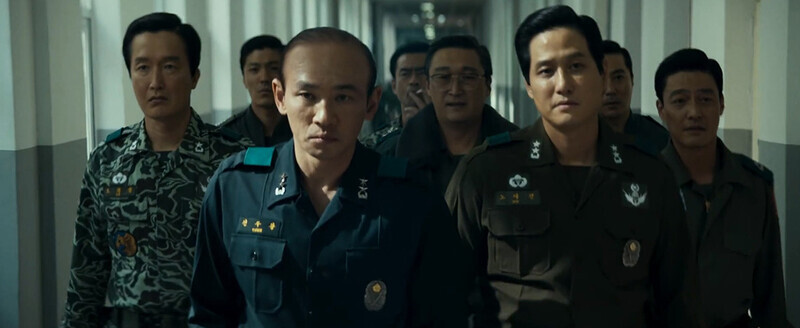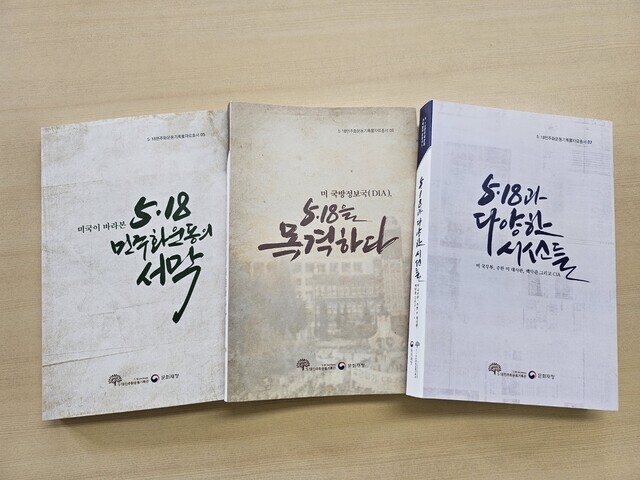all > National
Classified documents reveal Washington’s shifting perception of Chun’s 1979 mutiny
Posted on : 2024-01-04 17:19 KST Modified on : 2024-01-04 17:19 KST
Facebook 페이스북
Twitter 트위터
The documents in a newly published series confirm that the US was aware of the coup being organized by politically motivated soldiers on Dec. 12, 1979

Still from “12.12: The Day,” a fictionalized account of the military mutiny led by Chun Doo-hwan in 1979. (courtesy of Megabox PlusM)
“We have been through a coup in all but name. The flabby facade of civilian constitutional government remains but almost all signs point to a carefully planned takeover of the military power positions by a group of ‘young Turk’ officers.”
— US Ambassador to South Korea William H. Gleysteen in communication to the US State Department at 9:27 am on Dec. 13, 1979
A recently published three-volume series of materials related to the democratization movement in Gwangju and the resulting massacre in May 1980 includes a striking series of documents composed by the US intelligence community around the time of the coup on Dec. 12, 1979. The series brings together American documents that were donated to the city of Gwangju in 2017 by Tim Shorrock, an American reporter.
These documents consist of cables that were urgently transmitted between the US Embassy in South Korea and the State Department during the events in Gwangju in May 1980, the minutes of meetings held by senior bureaucrats in the White House, military intelligence collected in utmost secrecy from various corners of Korean society by the Defense Intelligence Agency, and CIA analyses of how the US government ought to respond to the forces behind the coup, including Chun Doo-hwan.

One of the US intelligence documents regarding the Dec. 12 military coup.
The documents in this series confirm that the US was aware of the coup being organized by politically motivated soldiers on Dec. 12, 1979.
A US State Department document dated 7:51 pm on Dec. 12 says, “An incipient coup d’etat is in progress in Seoul,” going on to say: “In the early evening hours December 12 Seoul time (early morning Washington time), a group of ROK army officers centered apparently on Defense Security Force Commander General Chon Tu-hwan [Chun Doo-Hwan] and First Corps Commander Lt. Gen. Hwang Yong-si [Hwang Young-si], arrested Army Chief Of Staff and Martial Law Commander General Chung Sung-hwa [Jeong Seung-hwa].”
The US intelligence community referred to Chun’s clique by various names that symbolize the US’ changing perspective on the coup.
At 7:51 pm on Dec. 12, 1979, the US Department of State wrote, “General Chon has met with President Choi, and at one point tried to get Minister Ro [Roh Jae-hyeon, defense minister] and the other senior commanders to come to the presidency to ‘discuss replacement of the martial law commander.’”
“Minister Ro declined this invitation, fearing that he would become a hostage of the incipient coup forces,” the report states.
Here, Chun Doo-hwan’s forces were labeled as “coup forces.”
However, in a report written two days later, the same forces are referred to as “a new line-up” and “young Turk officers.”
A report made by the US Embassy in Seoul at 8:03 am on Dec. 13, 1979, states, “More than ever he [President Choi Kyu-hah] is cut off from support and dependent upon a new line-up within the ROK military establishment.”
At 9:27 am on the same day, the embassy sent a report referring to those taking power of the military as “a group of ‘young Turk’ officers.”
“Turk” is slang used to refer to insurgents or troublemakers.
A US intelligence report on Dec. 13 uses the phrases “new military group” and “new military hierarchy.” A different phrase, “new army leadership group,” appears in a report made on Jan. 26, 1980. The coup forces were thusly upgraded from the initial “troublemakers” to “new army leadership group.”

The three-volume collection of records of the May 18 Gwangju Democratization Movement, which includes US records donated to the city of Gwangju in 2017 by American journalist Tim Shorrock. (courtesy of the May 18 Democratic Uprising Archives)
The reports also cover in detail how South Korea’s defense minister at the time tried to flee from the military mutiny on Dec. 12, 1979. An US Department of State document said that Defense Minister Roh Jae-hyeon, Joint Chiefs Chairman Gen. Kim Jong-hwan and Combined Forces Commander Gen. Lew Byong-hion had been until a short time before sending, physically in the UN Command bunker at Yongsan along with UNC Commander Gen. Wickham and Ambassador Gleysteen. (Report sent by the US Department of State to the US ambassador in Seoul at 4:51 am on Dec. 13, 1979.)
Lee Jae-eui, a researcher of the Gwangju democratization movement who edited the volumes, commented, “Many documents detailing the actions of Chun Doo-hwan difficult to find in South Korean documents are included, which makes me excited about the fact that many researchers will be able to delve deeper in their research and unearth new truths.”
By Jung Dae-ha, Gwangju correspondent
Please direct questions or comments to [english@hani.co.kr]
Related stories· The harrowing real-life stories of the Korean military coup depicted in “12.12: The Day”
· [Column] Chun Doo-hwan and Roh Tae-woo, Yoon Suk-yeol and Han Dong-hoon
· When and why did Koreans go from anti-American to pro-US?
· Salt in the wound: Chun’s 40-year legacy in Gwangju
· American investigative journalist highlights US role in suppression of Korean democracy movem
No comments:
Post a Comment